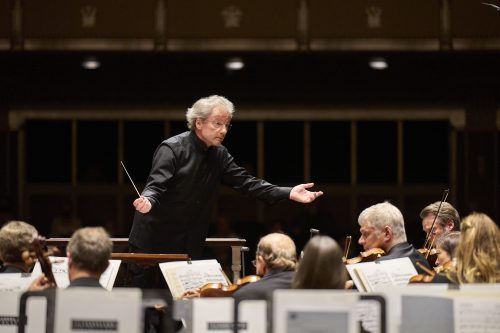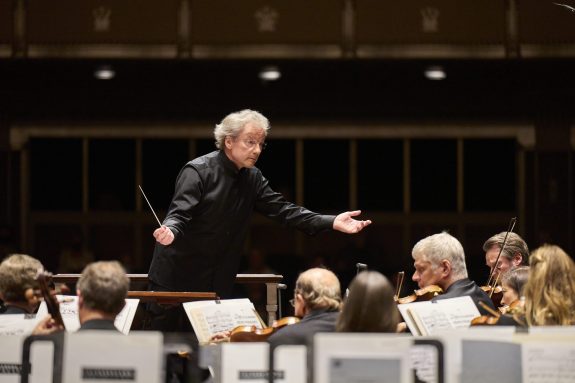 United States Summers at Severance 2024 [2]: Cleveland Orchestra / Franz Welser-Möst (conductor). Mandel Concert Hall at Severance Music Center, Cleveland, 15.8.2024. (MSJ)
United States Summers at Severance 2024 [2]: Cleveland Orchestra / Franz Welser-Möst (conductor). Mandel Concert Hall at Severance Music Center, Cleveland, 15.8.2024. (MSJ)

Mozart – Symphony No.35 in D major, K.385, ‘Haffner’
Bruckner – Symphony No.4 in E-flat major, ‘Romantic’ (1878/80 version, ed. Benjamin M. Korstvedt)
The final ‘Summers at Severance’ concert was an important occasion. It marked the return of music director Franz Welser-Möst to the Cleveland Orchestra in advance of a European tour that will follow the final concert of the Blossom Music Festival on Saturday. It also marked the first Cleveland performance of the new critical edition, edited by Benjamin Korstvedt, of the standard 1878/80 revision of Bruckner’s Symphony No.4. Above all, it stood as a signpost for what the conductor has built in Cleveland.
Bruckner’s Fourth makes extensive and impressive use of the brass section, and this concert was a fine reminder of how the Cleveland Orchestra’s brass have grown over the years. I first started attending Cleveland concerts in the 1980s, when the brass section was less powerful than now. Then-music director Christoph von Dohnányi focused on hiring new players to strengthen the section, and Welser-Möst has continued that growth, to the point where the entire section is magnificent. They can play with tremendous weight and burnished glow while keeping their strength mostly in reserve. Welser-Möst only rarely brought them in at full force in a patient and potent performance, but when he did, it was tremendous.
The entire orchestra was in great form, proving that even as epic a piece as Bruckner’s Fourth can be made to sound perfectly at home in the intimate acoustics of the Mandel Concert Hall. Welser-Möst chose tempos that allowed the music to unfold without haste or exaggerated gear changes, and he kept his vision on the big picture, not getting lost in the myriad details along the way. This allowed the expansive symphony to take time sketching out its wide-ranging vision, and to unfold as if in a single breath.
Particularly successful was the slow movement, which can seem endless in many performances. It sounds like a sort of nocturnal procession, or perhaps the thoughts of a solitary wanderer walking at night. Most performances degenerate into a mushy trudge that makes the music feel endless instead of timeless, but Welser-Möst quietly kept things moving, encouraging a lithe rhythmic response by the Cleveland strings – with gorgeous singing from the violas and cellos – that kept it focused. German conductor Wilhelm Furtwängler used to slow down and trail off of every phrase in the main theme, an evocative but eventually tiring mannerism. Welser-Möst instead achieved an evocative feel by keeping the basic tempo going while slightly dovetailing those phrases and building phrase upon phrase. It was a subtle but important way of making the music feel organic. I also adore that Welser-Möst avoided the usual spots where the movement can sag at transitions, places where many conductors attempt to linger. Here, the lingering emotion registered without letting the quiet pulse falter.
The Scherzo was exciting, without a reckless, hyped-up tempo. Welser-Möst allowed enough space for the brass to register with fullness of tone, without unleashing them at full force. Best of all was the quiet trio, which was played with a tender dreaminess as exquisite as anything I have ever heard. The woodwinds were a miracle of warmth and color.
The Finale of Bruckner’s Fourth is the most difficult, with its triple-theme sonata form threatening to derail because of the extreme changes of mood from section to section. Welser-Möst charted a steady course with his eye on the cathartic close, which was achieved with a profound sense of accomplishment. The most evident change of the Korstvedt edition of the score was the omission of the return of the first movement’s theme in the horns during the final peroration, but it did not keep the closing pages from soaring. It was amazing to watch a Midwestern American audience in the age of TikTok stop their desperate, restless search for distraction for seventy minutes to be taken to an entirely other spiritual level by a plain-spoken but profoundly gripping performance of a symphony, and then erupt in an ecstatic ovation. It proves how hungry people are for real substance. It makes me think there is hope for this world.
No less profound, in its way, was the performance of Mozart’s ‘Haffner’ Symphony. Written for a patron whose name still graces it, the ‘Haffner’ is a miracle of joyful grace. It is the kind of score that Welser-Möst would have conducted a little rigidly twenty-five years ago. But these days, he has grown immensely in his ability to make non-programmatic music speak. Without ever introducing crude exaggerations, he has learned how to let phrases ebb and flow, making Mozart’s lucid writing unfold almost like human speech. The music spoke with elegant charm, taking off like a rocket in the quick and witty final movement, the Cleveland violins at their nimble best.
Music-making on this level brings deep joy, and it showcased the best aspects of Welser-Möst’s tenure in Cleveland. There are still those who dislike his reserved and understated way, but performances like this prove just how much can be said without frothing at the mouth and grandstanding. It was simply eloquent.
Mark Sebastian Jordan

I wasn’t at the concert, but I downloaded the new Cleveland Orchestra recording of the Bruckner 4th, and enjoyed it very much. I disagree with Mr. Jordan’s reservation with the Cleveland brass of past. Szell, Maazel and Dohnányi cultivated a more balanced ensemble where at climaxes the strings could still be heard (unlike other orchestras). Musicians retire, die or move on, but principal horn Myron Bloom under Szell was legendary and I was always partial to Richard Solis’s laid back poetic French horn under Maazel into Dohnányi. FWM seems to favor the brass and winds over the strings, but there’s better string articulating on his recording of the Bruckner 4th compared to Dohnányi’s from the 1990’s, but the latter has a warmer, fuller string sound. Great orchestras give the conductor what he or she wants if convincing, and there’s no point to live music making by replicating what has been done in the past.
As for the Mozart, let’s just hope that the next Cleveland boss doesn’t take so long to settle in to produce good Mozart performances. Dohnanyi was pretty good here, but often didn’t go for a crisp ensemble like Szell. However, despite programming all Mozart concerts every season, to many this was not a Maazel success (outside of operas).
I came across this review and your comment by accident – as I was searching for something else. But since I’m here, I thought I would add my endorsement of your opinion concerning the brass playing. I’ve heard the Cleveland Orchestra for so many years I’m beginning to withhold the details! And I am a fan of the brass, having had some very modest experience in that line – but at least enough experience to appreciate the difficulties. Dohnányi’s brass section was just fine, and I do believe this is a matter of Welser-Möst’s style and preferences. Back in W-M’s second year, as I recall, I heard his Bruckner Seventh and remember commenting to a friend that the brass were playing ‘Chicago-style’. And just a couple years earlier I had heard three Bruckner performances – from Dohnányi, Ling, and Welser-Möst – and the latter’s struck me as distinctly louder in the brass, although not oppressively so. On the other hand, W-M certainly doesn’t neglect the strings, but commands some truly remarkable discipline from them. Also, outstanding winds. A great orchestra.
Memories of a sleek, elegant, yet most coherent and powerful performance of Bruckner’s Eighth by F W-M in Leipzig with the Gewandhausorchester in 2017 compelled me to fly in from Boston for this concert. How glad I am to have attended! To quote a critic friend: F W-M is one of the most refined conductors of our time.
I concur with the author’s assessment ‘best of all was the quiet trio’ – only somebody as well-versed in the great Austro-Germanic tradition as Welser-Möst could use such subtle rubato in the opening upbeat. Equally impressive was, however, the dynamic control in the first movement – unlike most (pardon the pun), Welser-Möst did not go full blast at the first tutti after the introduction – thereby impressively changing the arch of the movement’s argument.
I left Severance Hall with no doubt that the Cleveland is America’s finest, but also wondering if F W-M, with all his central European qualities as a musician, would have lasted so long anywhere else in America. (The ‘rival’ orchestra up the road likes it flashy, doesn’t it?) I am sorry to hear he shall be leaving in 2027. Let’s hope the orchestra will be as wise then as it was at the start of the century, when it bravely took him on at the sage advice of Christoph von Dohnányi.